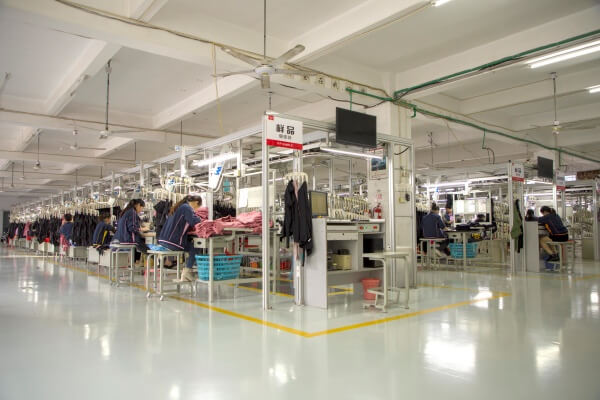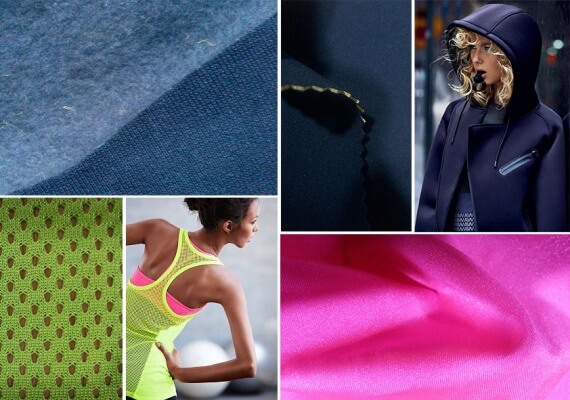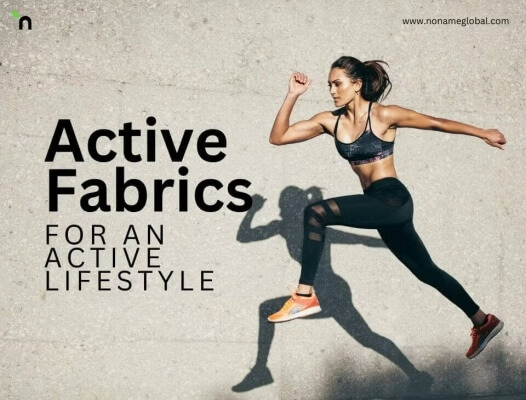تنسيق مجموعتك: دليل B2B إلى ActiveWear & أنماط ارتداء اليوغا ، وظائف & خيارات المواد؟
تكافح العديد من الشركات من أجل تطوير مجموعة متنوعة متوازنة. إما أنها توفر خيارات قليلة للغاية ، أو الحد من جاذبية المستهلك ، أو إنشاء مجموعة هائلة من المنتجات التي تعقد إدارة المخزون وتخلط العملاء.
يجب أن تتضمن مجموعة Activewear المنسقة جيدًا المواد الغذائية الأساسية (طماق ، حمالات الصدر الرياضية ، الدبابات) في مختلف مستويات الأداء ، تكملها قطع الاتجاه الموسمية. ضع في اعتبارك الديموغرافية المستهدفة عند اختيار الأنماط-الرياضيين الذين يركزون على الأداء الأولوية يعطي الأولوية للوظائف ، في حين أن مستهلكي Athleisure يوازن بين الأداء مع جاذبية الموضة.

في وجودنا ، ساعدنا العشرات من العلامات التجارية على تطوير مجموعات ناجحة للأزياء النشطة. لقد أعطتنا تجربتنا في تصنيع أكثر من 30 مليون دولار في المبيعات السنوية لأكثر من 3000 متجر رؤى فريدة حول ما يجعل تشكيلة منتجات مقنعة. اسمحوا لي أن أشارك ما تعلمناه حول إنشاء مجموعة متوازنة تزيد من المبيعات مع تقليل تعقيد المخزون.
ما هي الأساليب التي يجب أن تتضمنها مجموعة ActiveWear الخاصة بك؟
غالبًا ما يكون اختيار الأسلوب هو التحدي الأول الذي تواجهه الشركات. دون فهم تفضيلات المستهلك ، من السهل تفويت أنماط رئيسية تدفع المبيعات أو تتضمن خيارات متخصصة مع جاذبية محدودة.
تتضمن مجموعة Activewear الشاملة عادة قيعان (طماق ، شورتات ، ركض) ، قمم (حمالات الصدر الرياضية ، الدبابات ، المحملات) ، وقطع الطبقات (السترات ، هوديس). يجب أن توفر كل فئة خيارات للأنشطة المختلفة ، من التدريب عالي الكثافة إلى اليوغا إلى Athleisure ، مع أنماط تعكس تحديد المواقع الفريدة للعلامة التجارية والعميل المستهدف.

عندما بدأنا في تصنيع الملابس النشطة لأول مرة ، ركزت معظم العلامات التجارية على مجموعة محدودة من الأنماط. اليوم ، ننتج مجموعات شاملة تلبي احتياجات المستهلك المتنوعة. إليك ما تعلمناه حول وضع السوق لكل نمط وجاذبية المستهلك:
فئات النمط الأساسي
القيعان
طماق/لباس ضيق
- موقف السوق: أساس أي مجموعة ActiveWear
- نداء المستهلك: التنوع والراحة والأداء
- الاختلافات النمط: الطول الكامل ، 7/8 الطول ، عالي المهدئة ، منتصف الارتفاع
- اعتبارات وظيفية: عتامة ، استقرار حزام ، بناء gusset
عادةً ما تمثل اللباس الداخلي 40-50 ٪ من مبيعات ActiveWear لمعظم العلامات التجارية. نوصي بتقديم ما لا يقل عن 2-3 أنماط أرجل أساسية مع ميزات مختلفة (على سبيل المثال ، الجيب مقابل لا جيب ، مستويات ضغط).
سراويل
- موقف السوق: ضروري للطقس الدافئ والتدريب عالي الكثافة
- نداء المستهلك: التبريد ، حرية الحركة
- الاختلافات النمط: شورت الدراجة ، السراويل القصيرة ، السراويل القصيرة
- اعتبارات وظيفية: خيارات الطول ، بطانة مقابل لا بطانة ، ميزات مضادة للركوب
تمثل السراويل القصيرة 15-25 ٪ من المبيعات ، مع نسبة مئوية أعلى في الأشهر أو المناطق الأكثر دفئًا.
الركض/سروال التعرق
- موقف السوق: تنامي فئة سد الأداء ونمط الحياة
- نداء المستهلك: الراحة ، التنوع ، تصميم Athleisure
- الاختلافات النمط: رفيع النحافة ، ملاءمة مريحة ، اقتصاص
- اعتبارات وظيفية: الاسترداد الممتد ، وظائف الجيب ، تصميم الكاحل
عادةً ما تمثل الركض 10-20 ٪ من مبيعات القيعان ، مع نسبة مئوية أعلى في مواسم أكثر برودة.
قمم
حمالات الصدر الرياضية
- موقف السوق: قطعة أساس أساسية
- نداء المستهلك: الدعم والراحة والأناقة
- مستويات الدعم: الضوء ، المتوسط ، التأثير العالي
- الاختلافات النمط: Racerback ، Crossback ، Longline ، المحاصيل
تمثل حمالات الصدر الرياضية 20-30 ٪ من مبيعات TOPS ، مع وجود مستويات دعم مختلفة مطلوبة لمختلف الأنشطة.
الدبابات/camis
- موقف السوق: نمط أساسي متعدد الاستخدامات للأنشطة المتعددة
- نداء المستهلك: حرية الحركة ، التبريد ، الطبقات المحتملة
- الاختلافات النمط: Racerback ، ملاءمة فضفاضة ، اقتصاص ، خط طويل
- اعتبارات وظيفية: دعم مدمج مقابل إدارة الرطوبة المستقلة
عادةً ما تمثل الدبابات 30-40 ٪ من مبيعات TOPS ، خاصة في الأشهر الأكثر دفئًا.
القمصان/الأكمام الطويلة
- موقف السوق: ضروري للأنشطة الخارجية والتغطية المتواضعة
- نداء المستهلك: حماية الشمس ، براعة ، خيار متواضع
- الاختلافات النمط: مجهز ، مريح ، اقتصاص ، قياسي
- اعتبارات وظيفية: حماية UPF ، رطوبة الرطوبة ، تجفيف سريع
تمثل المحملات 20-30 ٪ من مبيعات TOPS ، مع الأكمام الطويلة أداء أفضل في مواسم أكثر برودة.
الملابس الخارجية
السترات/هوديس
- موقف السوق: إكمال خزانة الملابس النشطة
- نداء المستهلك: الدفء ، تغطية ما قبل/ما بعد التمرين ، تصميم Athleisure
- الاختلافات النمط: زيب كامل ، نصف زيب ، pullover ، سترة
- اعتبارات وظيفية: التهوية ، التمدد ، وظائف الجيب
تمثل الملابس الخارجية عادة 10-15 ٪ من إجمالي مبيعات التحصيل ، مع نسبة مئوية أعلى في الخريف/الشتاء.
اعتبارات اليوغا الخاصة
يوجا ارتداء المتطلبات الفريدة التي تميزه عن الأزياء العامة العامة:
- امتداد محسّن: مجموعة أكبر من الحركة لطرح
- حزام الخصر الآمن: ابق التصميم أثناء الانقلابات
- الحد الأدنى من الأجهزة: تجنب العناصر التي تضغط على الجسم أثناء عمل الأرضية
- وضع التماس الاستراتيجي: منع نقاط الضغط أثناء الجلسات
- التركيز الغضب: ضمان عدم الاضطراب أثناء التمدد العميق
للحصول على معلومات مفصلة عن التكنولوجيا والمواد المستخدمة في هذه الأنماط المختلفة ، تفضل بزيارة دليلنا الشامل: Activewear & تقنية ارتداء اليوغا & المواد: دليل المشتري لأقمشة الأداء ، البناء & متانة.
كيف توازن بين الوظيفة والأزياء في مجموعتك؟
إن إنشاء ملابس نشطة تعمل بشكل جيد أثناء تلبية توقعات نمطها أمر صعب. العديد من الشركات إما الإفراط في المؤشر على الميزات الفنية على حساب الجماليات أو إعطاء الأولوية للأزياء دون وظائف كافية.
توازن مجموعات ActiveWear الناجحة في التوازن بين الوظيفة والموضة من خلال إنشاء مجموعة متنوعة: القطع التي تركز على الأداء مع أقصى ميزات تقنية للرياضيين الجادين ، وأنماط الاستوديو/اليوغا التي تؤكد على الراحة والحركة مع ميزات تقنية معتدلة ، وقطع Athleisure التي تمزج عناصر الأداء مع تصميم الأزياء للأزياء للارتداء اليومي.

في الحصول على شركائنا ، نساعد شركائنا على تطوير مجموعات تلبي احتياجات المستهلك المختلفة عبر طيف الأزياء. إليك نهجنا لإنشاء مجموعة متنوعة:
فئات الأداء
| فئة | التركيز الفني | تركيز النمط | ٪ من التجميع |
|---|---|---|---|
| عالي الأداء | الميزات التقنية القصوى | الجماليات التي تعتمد على الوظيفة | 20-30 ٪ |
| Studio/Yoga | ميزات تقنية معتدلة | الوظيفة المتوازنة والأناقة | 30-40 ٪ |
| athleisure/نمط الحياة | الميزات الفنية الأساسية | النمط إلى الأمام مع مزايا الأداء | 30-50 ٪ |
الميزات الفنية حسب الفئة
عالي الأداء
- الحد الأقصى لإدارة الرطوبة
- عناصر الضغط
- نقاط التوتر المعززة
- ميزات خاصة بالنشاط
- تفاصيل عاكسة للرؤية
- بناء التماس الفني
Studio/Yoga
- أقمشة ممتدة رباعية الاتجاه
- عتامة ممتازة
- يشعر اليد الناعمة
- الحد الأدنى من اللحامات
- حزام الخصر الآمن
- ضغط معتدل
athleisure/نمط الحياة
- الأقمشة التي تركز على الراحة
- تفاصيل الموضة إلى الأمام
- خيارات التصميم متعددة الاستخدامات
- خصائص رعاية سهلة
- كروس إمكانات
- العناصر المستجيبة الاتجاه
موازنة تشكيرك
يعتمد التوازن المثالي على عميلك المستهدف ومواقع العلامة التجارية:
- العلامات التجارية التي تركز على الأداء: 40 ٪ عالية الأداء ، 40 ٪ الاستوديو/اليوغا ، 20 ٪ athleisure
- اليوغا/العلامات التجارية العافية: 20 ٪ عالية الأداء ، 60 ٪ الاستوديو/اليوغا ، 20 ٪ athleisure
- علامات تجارية للأزياء: 10 ٪ عالية الأداء ، 30 ٪ الاستوديو/اليوغا ، 60 ٪ athleisure
للحصول على رؤى حول اتجاهات السوق التي يجب أن تُعلم تطوير مجموعتك ، تفضل بزيارة تحليلنا التفصيلي: فهم الملابس النشطة & سوق ملابس اليوغا: الاتجاهات ، التركيبة السكانية & فرص المشترين B2B.
كيف تختار مواد لأنشطة مختلفة؟
يؤثر اختيار المواد بشكل كبير على كل من الأداء وتصور المستهلك. الأنشطة المختلفة لها متطلبات مميزة للأقمشة يجب معالجتها لنجاح المنتج.
يجب أن يتماشى اختيار المواد مع النشاط المقصود: التدريبات عالية الكثافة تحتاج إلى أقمشة خفيفة الوزن ، أقصى رطوبة (مزيج من البوليستر) ؛ تتطلب اليوغا أن اللمس الناعم ، غير شفاف مع امتداد ممتازة (مزيج من النايلون-إكليدركس) ؛ في حين أن قطع Athleisure تستفيد من الأقمشة المريحة والسهلة للرعاية التي توازن الأداء مع قابلية ارتداء اليومية.

في وجود ، نطابق خصائص النسيج مع متطلبات النشاط المحددة. إليك دليلنا لاختيار المواد المناسبة لتطبيقات مختلفة:
توصيات المواد حسب النشاط
التدريب عالي الكثافة/الجري
الأقمشة المثالية:
- مزيج بوليستر/الإيلاستين خفيف الوزن (80-85 ٪ بوليستر ، 15-20 ٪ من الإيلاستين)
- لوحات شبكية للتهوية
- هياكل متماسكة تقنية لتعزيز الفتل
الخصائص الرئيسية:
- إدارة الرطوبة متفوقة
- القدرة على التجفيف السريع
- شعور خفيف الوزن
- المتانة ممتازة
- مقاومة الرائحة
نطاق الوزن: 140-200 GSM (غرام لكل متر مربع)
أنشطة اليوغا والاستوديو
الأقمشة المثالية:
- مزيج من النايلون/الإيلاستين (75-80 ٪ من النايلون ، 20-25 ٪ الإيلاستين)
- الأقمشة المصنوعة من أجل الشعور باليد الناعمة
- البناء امتداد رباعي الاتجاه
الخصائص الرئيسية:
- الحد الأقصى للتمدد والانتعاش
- العتامة عند امتدادها
- لمسة ناعمة ضد الجلد
- ضغط لطيف
- مظهر غير لامع
نطاق الوزن: 220-280 GSM للهدوء ، 180-220 GSM للقمم
الأنشطة في الهواء الطلق
الأقمشة المثالية:
- مزيج بوليستر متين
- أقمشة مصنفة UPF
- الإنشاءات المقاومة للتآكل
الخصائص الرئيسية:
- حماية الأشعة فوق البنفسجية
- مقاومة الطقس
- متانة
- تجفيف سريع
- تنظيم درجة الحرارة
نطاق الوزن: يختلف بحلول الموسم (140-180 GSM Summer ، 200-300 GSM Winter)
athleisure/نمط الحياة
الأقمشة المثالية:
- مزيج القطن/الإيلاستين
- مزيج مشروط/الإيلاستين
- البوليستر/الإيلاستين المصقول
الخصائص الرئيسية:
- تركيز الراحة
- يشعر اليد الناعمة
- رعاية سهلة
- تمتد للحركة
- مظهر غير رسمي
نطاق الوزن: 200-320 GSM للهدوء ، 150-220 GSM للقمم
مخطط مقارنة المواد
| مادة | أفضل ل | المزايا | اعتبارات |
|---|---|---|---|
| البوليستر/الإيلاستين | تدريب عالي الكثافة ، الجري | إدارة الرطوبة الفائقة ، المتانة ، الصعود | شعور أقل ناعمًا ، إمكانية الاحتفاظ بالرائحة |
| النايلون/الإيلاستين | اليوغا ، أنشطة الاستوديو | امتداد/استرداد ممتاز ، شعور ناعم ، عتامة | ارتفاع تكلفة ، أقل رطوبة من البوليستر |
| القطن/الإيلاستين | الأنشطة الخفيفة ، athleisure | الشعور الطبيعي ، والتنفس ، والراحة | إدارة الرطوبة الضعيفة ، تجفيف أبطأ |
| البوليستر المعاد تدويره | مجموعات واعية للبيئة | قصة الاستدامة ، أداء مماثل للعذراء | تكلفة أعلى قليلاً ، تحديات الاتساق المحتملة |
للحصول على معلومات مفصلة عن خصائص المواد وخصائص الأداء ، تفضل بزيارة دليلنا الشامل: Activewear & تقنية ارتداء اليوغا & المواد: دليل المشتري لأقمشة الأداء ، البناء & متانة.
كيف يمكنك بناء خط إنتاج لا يقل عن قابلية للحياة؟
تكافح العديد من الشركات مع تحديد نقطة البداية الصحيحة لخط الملابس النشطة. إن بدء حدود صغيرة جدًا ، مع بدء تشغيل كبير جدًا ، يخلق مخاطر مالية.
تشتمل مجموعة الأزياء النشطة القابلة للحياة عادةً على 2-3 أنماط أسفل (طماق أو شورت أو ركض) ، 2-3 أنماط أعلى (حمالة صدر رياضية ، دبابة ، تي شير) ، وقطعة خارجية واحدة. يجب تقديم كل نمط بألوان 2-3 (أسود بالإضافة إلى 1-2 ألوان موسمية). هذا يخلق 10-15 SKU-بما في ذلك لاختبار استجابة السوق مع تقليل الاستثمار في المخزون.

في وجودنا ، ساعدنا العديد من العلامات التجارية في إطلاق أول مجموعات ActiveWear الخاصة بها. بناءً على هذه التجربة ، إليك نهجنا الموصى به لبناء خط إنتاج لا يقل عن:
استراتيجية جمع الأساس
بالنسبة للعلامات التجارية التي تدخل الفئة ، نوصي عادة:
الخطوة 1: حدد الأنماط الأساسية
اختر 4-6 الأنماط التأسيسية:
- Legging عالية مخصصة (ضرورية لأي خط Activewear)
- حمالة الصدر الرياضية (الدعم المتوسط هو الأكثر تنوعا)
- TANK TOP أو TEE (بناءً على تفضيل العميل المستهدف)
- السراويل القصيرة أو الركض (اعتمادًا على الموسمية والعميل)
- اختياري: سترة خفيفة أو هوديي
الخطوة 2: تحديد الألوان
ابدأ بالألوان الأساسية:
- الأسود (يمثل 40-60 ٪ من مبيعات الأزياء النشطة)
- 1-2 ألوان موسمية أو ألوان توقيع العلامة التجارية
الخطوة 3: إنشاء مصفوفة SKU الخاصة بك
يؤدي هذا النهج عادةً إلى 10-15 SKU:
- 4-6 أنماط × 2-3 ألوان = 8-18 SKU
- مزيد من التكرير بناءً على قيود الميزانية
استراتيجية التوسع
بعد إطلاق ملاحظات المجموعة الأساسية وجمعك ، قم بالتوسع بشكل استراتيجي:
المرحلة 2: توسيع النمط
أضف 2-3 أنماط إضافية بناءً على ملاحظات العملاء وبيانات المبيعات:
- إذا كانت المجموعة الأساسية تركز على الأساطير ، أضف سراويل أو ركض
- قم بتوسيع نطاق اختيار TOPS بمستويات أو أنماط دعم مختلفة
- أضف قطع طبقات إذا ركزت المجموعة الأولية على الأساسيات
المرحلة 3: توسيع اللون
توسيع خيارات الألوان بشكل استراتيجي:
- محايد إضافي (البحرية ، الرمادي)
- ألوان الموضة الموسمية
- المطبوعات أو الأنماط
المرحلة 4: التوسع الوظيفي
أضف أنماطًا لأنشطة أو مناسبات محددة:
- قطع اليوغا المتخصصة
- معدات التدريب عالية الأداء
- العناصر كروس Athleisure
أمثلة جمع عن طريق تحديد موقع السوق
| وضع السوق | مجموعة أولية موصى بها | أولوية التوسع |
|---|---|---|
| العلامة التجارية التي تركز على اليوغا | صدرية متوسطة الدعم متوسطة الدعم ، صدرية متوسطة الدعم ، خزان مريح ، تغطية خفيفة بألوان أسود و 1-2 ألوان | أنماط أرجل إضافية ، دعائم اليوغا المتخصصة |
| تدريب الأداء | Leging Legging ، حمالة صدرية عالية الدعم ، نقطة الإنطلاق ، السراويل السوداء و 1-2 ألوان | قطع التدريب المتخصصة ، تكنولوجيا الأداء |
| العلامة التجارية Athleisure | أرجل اليومية ، حمالة صدرية داعمة الضوء ، دبابة متعددة الاستخدامات ، ركض باللون الأسود و 1-2 ألوان | قطع كروس نمط الحياة ، خيارات الألوان الموسعة |
| التركيز المستدام | الأنماط الأساسية في المواد المعاد تدويرها أو العضوية ، ألوان محايدة | مواد مستدامة إضافية ، ابتكارات صديقة للبيئة |
للحصول على إرشادات حول تطوير خط الملصق الخاص بك ActiveWear ، تفضل بزيارة موردنا التفصيلي: علامتك التجارية ، منتجك: الدليل الكامل للملصقات الخاصة (OEM/ODM) Activewear & اليوغا ارتداء التصنيع.
كيف يمكنك البضائع وتسويق أنماط مختلفة؟
التواصل الواضح حول وظائف الأناقة والميزات ضرورية. يطغى العديد من المستهلكين على المصطلحات الفنية ويكافحون لاختيار المنتجات المناسبة لاحتياجاتهم.
تستخدم تجارة Active Activewear أنظمة مرئية واضحة لتوصيل مستويات الأداء (الرموز ، وترميز الألوان ، أو أنظمة التصنيف) ، والتوصيات الخاصة بالنشاط ، والأوصاف التي تركز على الفوائد. إن تنظيم المنتجات حسب النشاط بدلاً من مجرد نوع المنتج يساعد المستهلكين على التنقل في المجموعات وإيجاد أنماط مناسبة لاحتياجاتهم.

في الحصول على شركائنا لتطوير استراتيجيات ترويجية فعالة لمجموعات الملابس النشطة. فيما يلي الأساليب الرئيسية التي وجدناها أكثر فعالية:
أنظمة الاتصالات الأداء
أيقونات النشاط
استخدم أيقونات بسيطة للإشارة إلى الأنشطة المقصودة:
- الجري/التدريب
- اليوغا/الاستوديو
- في الهواء الطلق
- كل يوم/athleisure
أنظمة تصنيف الأداء
توصيل المستويات الفنية بوضوح:
- مستويات دعم حمالات الصدر الرياضية (الضوء ، المتوسط ، المرتفع)
- مستويات ضغط القيعان (الضوء ، المعتدل ، شركة)
- تصنيفات إدارة الرطوبة (جيدة ، أفضل ، أفضل)
- تصنيفات الغضب (خاصة لارتداء اليوغا)
ميزة تسليط الضوء
لفت الانتباه إلى العناصر الوظيفية الرئيسية:
- تواجد الجيب والنوع
- تفاصيل عاكسة
- حماية UPF
- العلاج المضاد للظهور
- خصائص جافة
استراتيجيات الترويج
في المتجر التجارة
لبيئات البيع بالتجزئة:
- المناطق القائمة على النشاط بدلاً من مجرد أنواع المنتجات
- تجارة الزي (تظهر النظرات الكاملة)
- شرح الميزات الفنية
- حوامل النسيج لمقارنة اللمس
- لافتات تركز على الفائدة
الترويج عبر الإنترنت
للتجارة الإلكترونية:
- التصفية حسب النشاط وميزات الأداء
- ملاءمة مفصلة وأوصاف النسيج
- الحجم والتناسب أدلة خاصة بالملابس النشطة
- التصوير الفوتوغرافي الخاص بالنشاط
- فيديو يظهر الحركة والأداء
جمع القصص
إنشاء روايات متماسكة حول المجموعات:
- قصص قائمة على النشاط (مجموعة اليوغا ، مجموعة تشغيل)
- مجموعات تركز على الفوائد (مجموعة التبريد ، جمع الضغط)
- القصص القائمة على المواد (مجموعة معاد تدويرها ، مجموعة سلسة)
- الموضوعات الموسمية التي توحد منتجات متنوعة
للرؤى السوقية واستراتيجيات تعليم المستهلك ، استكشف تحليلنا التفصيلي: فهم الملابس النشطة & سوق ملابس اليوغا: الاتجاهات ، التركيبة السكانية & فرص المشترين B2B.
خاتمة
يتطلب إنشاء مجموعة ActiveWear المنسقة جيدًا موازنة تنوع النمط والأداء الوظيفي واختيار المواد لتلبية احتياجات السوق المستهدف. من خلال البدء بخط إنتاج لا يقل عن قابلية للتطبيق وتوسيع استراتيجي بناءً على ملاحظات المستهلكين ، يمكن للشركات بناء عروض ناجحة للملابس النشطة التي تقلل من مخاطر المخزون مع زيادة جاذبية السوق.
في امتلاكه ، نجمع بين خبرة التصنيع مع رؤى السوق لمساعدة شركائنا على تطوير مجموعات ActiveWear التي يتردد صداها مع المستهلكين ودفع نمو الأعمال.
للحصول على نظرة عامة شاملة على فئة ActiveWear بأكملها ، بما في ذلك اتجاهات السوق وفرص العمل ، تفضل بزيارة دليل B2B النهائي للمصادر & بيع Activewear & ارتداء اليوغا.
الأسئلة المتداولة (الأسئلة الشائعة)
ما هو أسلوب النشط الأكثر شعبية؟
تعد طماق مرتفعة مخصصة الاستمرار في نمط النشط الأكثر مبيعًا عبر معظم العلامات التجارية والأسواق ، وعادة ما تمثل 30-40 ٪ من إجمالي مبيعات الملابس النشطة بسبب براعة وراحتها ، والصورة الظلية المليئة.
كم عدد الأنماط التي يجب أن تتضمنها مجموعة ActiveWear الأولية؟
يمكن إنشاء مجموعة أولية قابلة للحياة مع 4-6 أنماط أساسية في 2-3 ألوان ، مما يؤدي إلى 8-18 SKU. هذا يوفر تنوعًا كافيًا لاختبار استجابة السوق مع تقليل الاستثمار في المخزون.
ما هي النسبة المثالية للقمم إلى القيعان في مجموعة ActiveWear؟
تحافظ مجموعات الأزياء الناجحة الناجحة على نسبة حوالي 1.5 قمم لكل نمط أسفل ، مما يعكس كيفية قيام المستهلكين عادة بشراء هذه العناصر وارتداءها (غالبًا ما يربطون عن قمم متعددة بنفس القاع).
هل يجب تحديث مجموعات ActiveWear موسمياً؟
نعم ، ولكن مع نهج متوازن: الحفاظ على الأساليب الأساسية على مدار السنة (60-70 ٪ من التجميع) مع تحديث الألوان الموسمية وإدخال أنماط مستجيب للاتجاه (30-40 ٪ من التجميع) على أساس موسمي.
ما هي الألوان الأفضل في ActiveWear؟
يمثل Black باستمرار 40-60 ٪ من مبيعات ActiveWear عبر معظم العلامات التجارية. ويشمل الفنانون الأقوياء الآخرون نغمات الجواهر البحرية والرمادية والعرق. عادة ما تؤدي الألوان الزاهية والمطبوعات بشكل أفضل في قمم من القيعان.
كيف يمكنني موازنة الأداء والقطع Athleisure في مجموعتي؟
يعتمد التوازن المثالي على عميلك المستهدف ، ولكن معظم المجموعات متعددة الاستخدامات تشمل حوالي 30 ٪ من القطع التي تركز على الأداء ، وأنماط الاستوديو/اليوغا بنسبة 40 ٪ ، و 30 ٪ عناصر Athleisure. اضبط هذه النسب المئوية بناءً على وضع علامتك التجارية وتفضيلات نشاط العميل.
